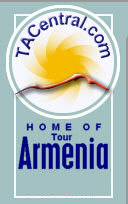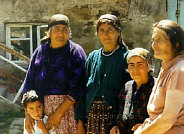The largest minority in Armenia are ethnic Russians. Russians are concentrated in Yerevan and Giumri (where the Russian border guard is based) and villages located mainly in Aragatsotn, Lori and Shirak Districts. Once numbering around 72,000, most recent census figures show the population of Russians in Armenia at around 12-13,000.
Russians came in large numbers beginning with the exile of Molokans in the 18th century to Armenia's "Siberia" at Amassia (see Molokan below), and Sevan ("Yelenovka"). There are about 5000 descendents of the original exiles in Armenia. The city of Sevan still holds some beautifully old, rambling houses inhabited by Molokan descendents, their windows resplendent with hand made lace curtains and Russian artifacts. In most towns where they reside visitors are welcome to spend the night, in return for a small 'contribution' ($15-20 a night is appropriate for room and board).
The Molokans
Break-off sects from the Orthodox church in Russia are traced back to the 1500's, with a surge in sectarian activity during the 17th and 18th centuries, as the Tsar and the Orthodox church concentrated their control over the country.
Escaping state persecution, sectarians in the central provinces of Russia moved further from the centers of power, to Siberia, Transcaucasia, Central Asia and the Crimea, influencing the local populations as they adapted to new customs and surroundings.
One of the most significant sects were the Molokans.
The ancestors of the Molokans are from the peasant class in Russia and a few other nationalities in the empire. By religion they belonged to the Orthodox (Greek - Russian) church, although the resist the worship of icons and other representations of God, which they consider corrupted and lifeless because they were created by an idea, not God. They profess the belief in an omnipresent God who lives in the soul of each human being.
They believe that all worship objects should be banished from religion, unholy and nothing more than idolatry. a sin against the Creator.
They might fairly be called the 'Country Baptists' of the Russian Orthodoxy, for their stark churches and stringent belief system. In fact the Molokans' doctrine was influenced by western Protestantism (Baptism in particular), rejecting the ecclesiastical church with its extravagant rituals and corrupt clergy.
Like many sectarian causes, the Molokan doctrine found ready adherents, especially in the 17th century, first among peasants then the lower middle and merchant class.
These "Old believers" were first called iconoclasts, then Molokans, because they did not observe fasts as dictated by the Orthodox church, ate meat and drank milk (Russian for milk is 'moloko'), which was a staple of the peasant's life then.
Persecutions ensued with a small respite granted by Alexander I in 1805 granting recognition and freedom to worship to the Molokans and another other sect, the Dukhobors (spirit-wrestlers). This was short lived, with persecutions and pogroms escalating from the ascendancy of Nikolai I, with a decree in 1830 forbidding Molokans to settle any land in the Russian empire except the Transcaucasus.
In Armenia
Large numbers of Russians immigrated after the Russo-Turkish War of 1827-28, where they established businesses and churches in Giumri (then called Alexandropol), Yerevan, Alaverdi, Vanadzor, Goris and Kapan, and settled farms and villages throughout the Northwest and mountainous regions of the country. The mass of immigration was part of a plan by Russian authorities to settle and exploit the lands they had just inherited from the Ottoman and Persians, and to create markets for the new Capitalism bounding up north.
From 1830 Old Believers (Molokans) increased settlement in Armenia, forbidden from settling elsewhere than the Caucasus. Russian settlements -- military and Cossack -- were founded in the northwest of Armenia and the adjoining regions on the route of the Russian army to Kars and farther to Erzerum.
The largest number entered after the Russian Revolution and Civil War. Persecuted like other religions in the Soviet Union, Molokans and orthodox made wealth nevertheless, farmers and villages (mostly Molokans) succeeding in the collectives and others taking over clerical and other positions in government, which now used Russian as the official language.
Outward migration began after the Great War, when younger Russians left Armenia for newly welcoming and richer lands in the Russian steppes, and accelerated after 1989 when the official language reverted to Armenia, denying Russians of clerical or other managerial positions. There are about 5000 Russian Molokans left, most in Yerevan (2000). Other towns include Vanadzor -- 80 people; Dilijan -- 200, Hrazdan -- 60; Sevan -- 80.
Molokans living in villages number almost as many as those in towns: Fioletovo -- 1,500; Lermontovo -- 800, Tashir region (where formerly 12,500 Molokans lived) -- 400; in Krasnoselsk (where formerly 3,000 people lived) -- 50.
Traditional Russian villages continue to exist at Amassia, Ashotsk (Shirak), Sevan and Semyonvka (Gegharkunik), Fioletovo, Lermontov, Pushkino, Sverdlov, Lernantsk, Medovka, Lerhovit, Petrovka, Tashir and Mikaielovska (Lori).




